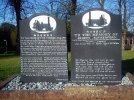Heartland
master brummie
There was a time in the early 1830's when there were carriage companies formed for the purpose of using steam power to haul carriages along the turnpikes and common roads. They included the use of Dr William Church's carriage which was assembled at Bordesley Green and the steam drag of Heaton Brothers. The Heatons decided to withdraw their engine after trials but the Church carriage continued in use for a short time until the opening of the London & Birmingham Railway when the company chose to withdraw also and the stock was put up for sale. Church then built a railway locomotive which saw trials on various lines before exploding at Bromsgrove.


